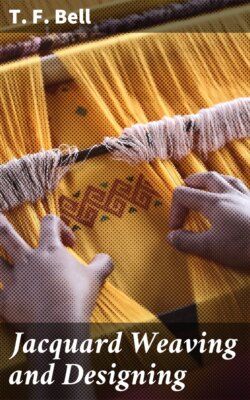Читать книгу Jacquard Weaving and Designing - T. F. Bell - Страница 7
На сайте Литреса книга снята с продажи.
THE COMB DRAW LOOM
ОглавлениеTable of Contents
Fig. 8
This machine appears to have been invented in both Scotland and Ireland, as Gilroy describes it as an invention of Dr. McLaughlin, of Ballyshannon, County Donegal; and Murphy describes a similar machine invented by Mr. Bonnar, of Dunfermline. The machine is shown in Fig. 8. A, A are the posts of the loom, and B B the top rail; C C is the framing of the machine. The harness G, G is suspended from the suspension board D, and passes through the guide board E and the cumber board F. The upper portion of the harness is composed of tail or knot cords, as in Cross’s machine. From each of the tail cords a simple cord, H, extends horizontally over the weaver’s head, and is fastened to the board I. The lashes K hang from the simples over the weaver’s head, and have a knob on the end of each, so that the weaver can catch them and draw his own draught.
Fig. 9
The lash cords have a knot or bead on them, so that when drawn they can be held in the cuts of the board L, also shown in plan at L (Fig. 9). M, N (Fig. 8) is a side view of the comb and handle, or lever, shown in plan at M, N (Fig. 9). S is a cord or chain attached to the end of the lever M, and passing down to a treadle. When the weaver draws one of the knobs, the tail cords connected with the simples in this lash are drawn between the teeth of the comb, as shown by the dotted lines in Fig. 8. He then depresses the treadle, which raises the comb, and the harness along with it; he holds the treadle down with his left foot, and works over the ground treadles with his right one. The comb is recovered or counterbalanced by the cord O, which passes from the comb through the board P, and has a weight, R, suspended on it. D (Fig. 9) is a plan of the boards D, E, F and I (Fig. 8).
